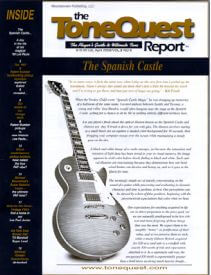
While Michael Bloomfield was playing cranked up blonde Fender Bassman and blackface Twin Reverb amplifiers, Marshall 100 watt stacks suddently appeared thanks to The Who, Jimi Hendrix, Cream and Led Zepplin. Throughout the ’70s, rock was dominated by the sound of a Les Paul and Marshall amps, but despite its reputation as the ultimate rock machine, all four-input, 100 watt Marshall model “1959” heads are not the same….
The first 100 watt Marshall amps appeared in late 1965,and despite Marshall’s decision to drop tube rectifiers for the less forgiving, harder sound of solid state diode rectification, the “Plexi” 100 watt heads remained more closely related to earlier Marshall amps inspired by the tweed Bassman than the Super Leads that would follow. In the early ’70s, the 50 watt model “1987” head and 100 watt Super Lead were gradually modified to produce more gain faster, and the bright channel was pushed to a punishing level of thin, ear-shattering brightness, while Channel II remained too dull and bassy to be used alone.
We acquired a 1973 Super lead—the last year before Marshall switched to printed circuit boards—for the modest sum of $1,000, made possible by a recent Dagnall replacement output transformer. Two .022 mf caps had been replaced with Orange Drops and another removed altogether in a futile effort to reduce brightness and gain—other-wise, the original Super Lead circuit remained intact and unmolested. Our plan was to run the amp at approximately 60 watts with just two EL34s, requiring the amp to be set at half the rated speaker impedance of our 8 ohm 4×12 Avatar cabinet, loaded with two Celestion Gold Alnico 12s and two “Hellatone” 70th Anniversary G12H 30s.
As we discussed this project with Jeff Bakos, he mentioned that the 100 watt Super Leads not only sound very different from the 50 watt heads in ways that transcend a mere increase in power, but he also felt that the 100 watt Super Lead amps sound better with just two powertubes instead of the full compliment of four…“That’s very common down here—I know a lot of layers who prefer that sound.” We also consulted with Sergio Hamernik of Mercury Magnetics on a suitable replacement for the modern Dagnall OT, and he suggested the ToneClone’69 Marshall self-leaded version. “Self-leaded” means that the actual wires wound within the transformer are extended to connect directly to the amp, rather than smaller diameter lead wires being attached to the transformer internally. Installing a self-leaded version is a bit of a bitch, since you are cutting and bending much heavier gauge wire to fit in tight spaces, and the insulation must be scraped off the wires before soldering. But Jeff had been here before,and all was taken in stride.
We also noted that the original power transformer in our ’73 Super Lead was similar to those found in the early Plexi100 watt amps with plate voltages well above 500 volts.
Our amp measured 522 volts, while the plate voltage on most post-plexi 100 watt “1959” amps are usually lower—around 460 volts. The “hotter” transformer in our Super Lead produces a comparatively higher and less compressed distortion threshold, and if not for our pair of NOS MullardEL34s, we might need to be more selective about choosing current production tubes that can withstand +500 volts on the plates. Jeff was confident that JJs would hold up, less confident of Svetlanas.
We took the Marshall home and initially ran it with three spare Telefunken 12AX7s just to see if they sounded as sterile in a guitar as we had recalled in the past. They do. We could hear a distinct improvement in the mid and bass tones with the new transformer, but the bright channel remained far too bright to be used alone, even with a Les Paul. While we could manage to knock down some of the treble and acquire a decent tone with the bright channel set on “3” and the bass channel patch with the volume on “6,”pushing Channel II so far above the level of bright channel introduced an indistinct woofiness we didn’t care for. The next day we returned to Jeff’s shop for his standard Marshall 4-banger input channel mod, which simply involves moving the original .005 mf bright cap on the bright channel to the basier Channel II. We had done this before with our ’69 50 watt and a vintage PA20, and it unerringly transformers the sound of the notoriously dull Channel II to a fat, warm, musically rich and bright sound that works perfectly every time. We also replaced the two Orange Drop caps with Mallory 150s and pulled the super hi-fi Telefunkens, replacing them with NOS RCA 12AX7s—the warmest, creamiest pre-amp tube ever made.
With the Super Lead thus optimized and tweaked, its voice was transformed from an angry soprano chain saw to a classic Marshall with all of the requiste thick,rich, historic hall of fame tones at our fingertips. We could mine brilliant clean tones on “3” at a usable volume level that revealed all the gorgeous detail of the vintage patent number pickups in our Historic Les Pauls, and our Stratocaster, Nocaster and Les Paul Junior all sounded equally good. Add Fender outboard reverb and you do indeed have the Twin from Bloody Hell.As Jeff predicted, the big power supply in the Super Lead also produced a much more formidable and impressive presence than a typical 50W. Yes, the Super Lead is still a beast, tamed for your consideration and our enjoyment. But if classic Marshall tone is the sound you crave, a properly groomed Super Lead is hard to beat, and given today’s boteek and vintage amp prices, it’s a solid steal.